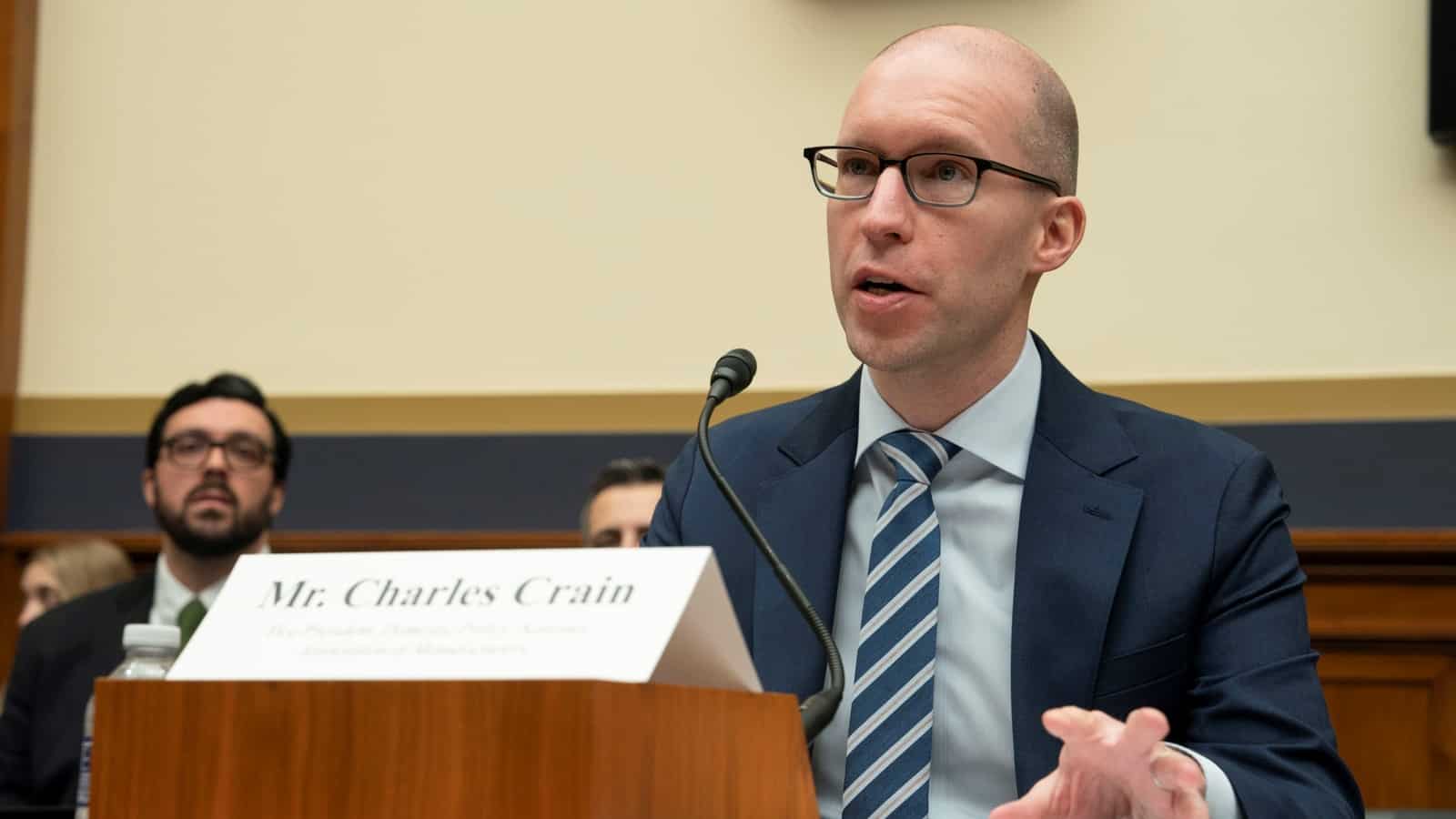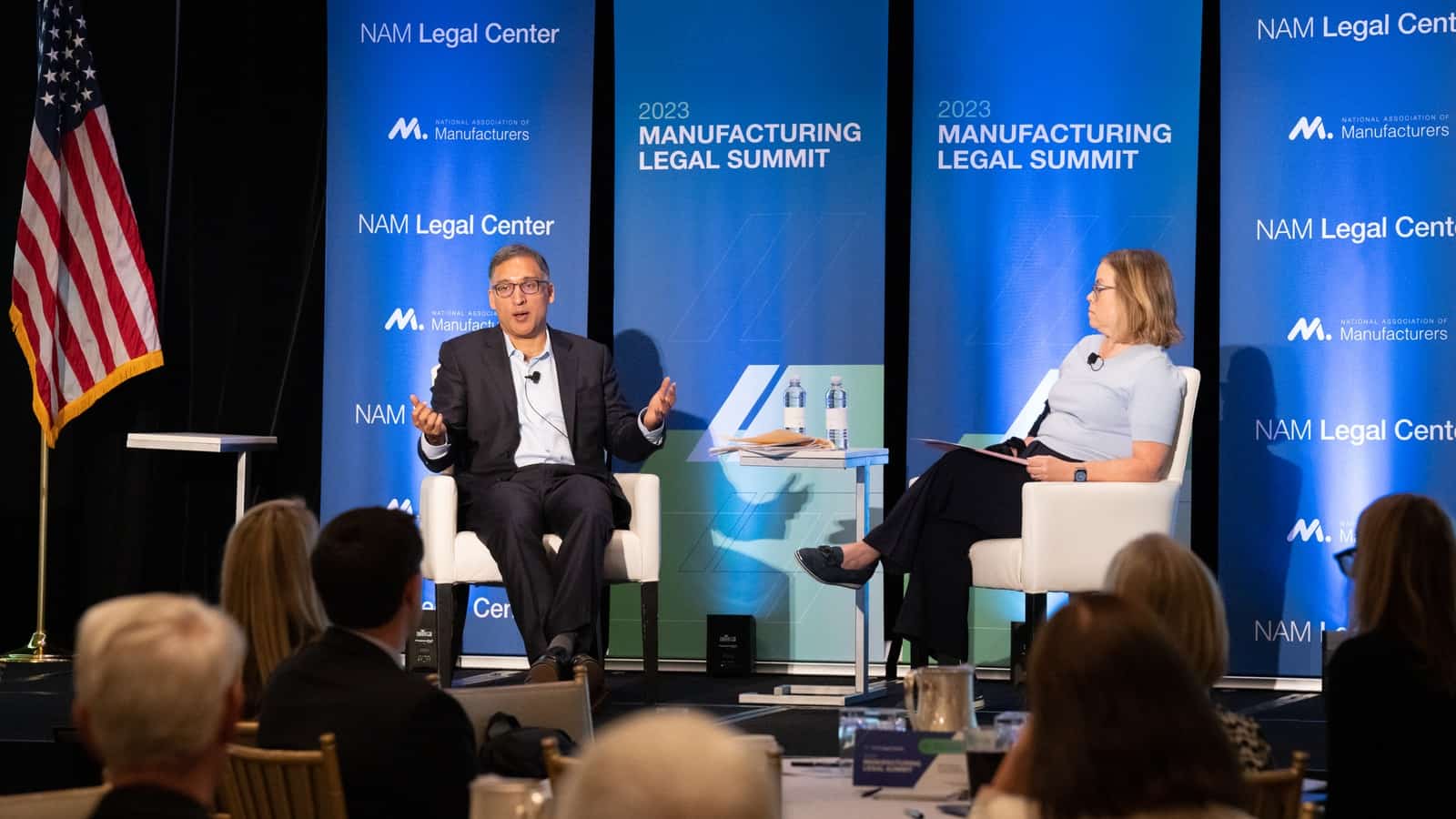NAM to Congress: SEC Must Fix Flawed Climate-Reporting Rule

The Securities and Exchange Commission’s pending climate disclosure rule would place an enormous, untenable burden on manufacturers—and impose a disproportionate hardship on small businesses, NAM Vice President of Domestic Policy Charles Crain told lawmakers Thursday.
What’s going on: Crain gave testimony before the House Financial Services Subcommittee on Oversight and Investigations on the damaging effects of the SEC’s proposed climate rule, which would require businesses to reveal large amounts of convoluted (and often sensitive) climate-related data.
- The plan would force disclosure of so-called “Scope 3” emissions—those that come from companies’ supply chains—and institute new climate-related accounting requirements, among other mandates.
Why it’s a problem: If finalized, the rule would divert funds from manufacturing growth, including at small manufacturers.
- “Manufacturing pioneers groundbreaking technologies, including the innovations necessary to combat climate change,” Crain said. “The rule would impose tremendous costs on manufacturers of all sizes—while overwhelming investors with immaterial information. And the SEC hasn’t done the work to show that the rule’s benefits outweigh its costs, or that the rule is even within the SEC’s legal authority.”
- The proposed regulation would, by the agency’s own accounting, “raise the cost to businesses of complying with its overall disclosure rules to $10.2 billion from $3.9 billion, an additional cost of about $530,000 a year for a bigger business,” according to The Wall Street Journal (subscription).
Costs to manufacturers: Crain told lawmakers that the SEC’s analysis likely understates the true costs of the rule, in part because the agency did not consider the impacts on private businesses.
- “For the larger companies subject to [the Scope 3] requirement, the SEC has admitted that it cannot ‘fully and accurately quantify’ the costs,” Crain said. “But for the small businesses that are swept into large companies’ Scope 3 efforts, the SEC hasn’t even tried. The SEC’s proposal does not include any discussion of the Scope 3 costs that will fall on small and private businesses.”
- Crain warned lawmakers that these compliance costs would represent a “huge resource diversion” for small manufacturers.
Regulatory onslaught: Crain shared the NAM’s landmark Cost of Federal Regulations study with lawmakers, explaining that the SEC’s proposal would add to the $50,000-per-employee-per-year regulatory burden small manufacturers face.
- “The SEC’s climate rule is at the center of this regulatory onslaught,” Crain said.
NAM in the news: Bloomberg (subscription), Law360 and Pensions & Investments all covered the NAM’s testimony.
House Passes Bill That Would Rein in PBMs

The House passed a health care package on Monday that includes measures to curb some practices by pharmacy benefit managers, according to STAT News.
What’s going on: The Lower Costs, More Transparency Leadership Act, which passed on a bipartisan vote, “would equalize payment between hospital outpatient departments and doctors’ offices for administering medicines in Medicare, rein in some practices by pharmacy benefit managers and codify health care price transparency rules.”
- The vote on the measure was scheduled for September originally but was pushed back amid a larger funding dispute.
What it means: The package would prohibit PBMs from “spread pricing”—or charging Medicaid more than they pay pharmacies for medications.
- It would also require PBMs, “clinical lab test providers, imaging providers [and] ambulatory surgical centers … to be more transparent about their pricing.”
What’s next: “Some community health advocates hope Monday’s vote will jump-start negotiations with the Senate, where leaders have signaled they’re looking for more than what’s in the House bill,” POLITICO reports.
Our view: “House passage of the Lower Costs, More Transparency Act is a step forward for PBM transparency, but Congress must continue to advance reforms that ensure PBMs pass on prescription drug discounts directly to plan sponsors and patients as well as delink their compensation from the list price of drugs,” the NAM said on Tuesday.
Right-to-Repair Laws Harm Manufacturers and Consumers

So-called “right-to-repair” policies undo many of the federal and state laws designed to protect consumers and manufacturers—and they could result in “steep cost[s] to quality, performance, consumer safety, the environment and the broader U.S. economy,” according to a new NAM-commissioned study.
What’s going on: “The Economic Downsides of ‘Right-to-Repair,’” by Capital Policy Analytics’ Ike Brannon and Kerri Seyfert, finds that enacting right-to-repair laws could disrupt supply chains, leave manufacturers open to intellectual property theft, drive up costs for consumers and manufacturers and increase greenhouse emissions in the atmosphere.
- Right-to-repair policies, currently in place in more than 30 states, generally require manufacturers to make all tools, guides and parts required to repair their devices available to everyone, including independent repair outfits.
- A federal right-to-repair law “would ultimately alter how manufacturers operate their businesses, and there is no guarantee that consumers would benefit, as manufacturers would be forced to change the way their products perform,” according to the study.
Why it’s important: “There is a wide range of unintended and potentially harmful consequences that would arise if the most commonly introduced versions of ‘right-to-repair’ go into effect,” Brannon and Seyfert write.
- In addition to making product repair more difficult, such policies could drastically increase compliance costs for manufacturers and drive up prices for consumers.
Reform PBMs, NAM Tells Congress

Pharmacy benefit managers—companies that were first established to manage the cost of prescription drugs—are now driving up pharmaceutical prices for employers and patients, the NAM told the House Committee on Energy and Commerce this week.
What’s going on: While manufacturers remain committed to providing health benefits to their workers, PBMs are “[c]ontributing to the increasing costs of health care,” said NAM Vice President of Policy Chris Netram on Monday, ahead of the committee’s markup of 44 pieces of legislation.
- These measures included the Protecting Patients Against PBM Abuses Act and the Medicare PBM Accountability Act.
Why it’s important: PBMs operate with a virtual monopoly, as just a few of them now control up to 89% of the prescription drug market, Netram continued.
- PBMs operate with limited federal oversight and frequently steer business toward pharmacy networks owned by their parent firms.
What should be done: Congress should pass legislation aimed at changing the PBM model.
- “The complex formulas and opaque business practices of PBMs must come to an end,” the NAM wrote in a social post Tuesday. “Congress must address PBM reform to increase transparency, ensure pharmaceutical savings are passed to the plan sponsor and patients and delink PBM compensation from the list price of drugs.”
In related news: CVS Health “will move away from the complex formulas used to set the prices of the prescription drugs it sells, shifting to a simpler model that could upend how American pharmacies are paid,” The Wall Street Journal (subscription) reports.
NAM Fights Restrictive Power Plant Rule

The Environmental Protection Agency is considering a rule that would change the way power plants operate in America—but without significant adjustments, it could have devastating consequences.
The background: Right now, about 60% of America’s power generation comes from a combination of coal and natural gas.
- The EPA’s proposed rule would require coal and natural gas–fired power plants to deploy either carbon capture technology or hydrogen power within 10 years to lower emissions.
- If unable to deploy these technologies at the scale required in that timeframe, these power plants would be forced to shut down.
The problem: While carbon capture and hydrogen power technologies are vital to decarbonization, the required scale and timeline make implementing this rule difficult.
- “Carbon capture and hydrogen are tremendously promising—and manufacturers are leading the way in developing these technologies. But neither have been deployed at the scale needed to support 60% of our entire power generation within a short timeframe,” said NAM Vice President of Domestic Policy Brandon Farris.
The timeline: The EPA’s proposed 10-year timeline leaves little room for flexibility when it comes to implementing the order. According to Farris, environmental impact studies alone could take more than four years.
- “We’re talking about 10 years to essentially retrofit more than half of our power generation,” said Farris. “You would need this permitted, installed and operational within those 10 years, which would be difficult even if the technology was available today at scale.”
The impact: The rule would require plants that do not meet the new standard in 10 years to shut down entirely. As a result, many plants would have to shift resources immediately to plan for a likely shutdown.
- “The big hammer is these plants having to shut down in 10 years if these technologies are not installed,” said Farris.
- “So you’ll see a lot of money spent and not a lot of progress made because this technology isn’t ready at scale, and we have only a few years to permit, install and operate.”
The next steps: The NAM has submitted comments on the rule, and the EPA is working on a final version now.
- “We’ve emphasized that the timeline is not workable,” said Farris. “You would need to have a longer off-ramp and a way to ensure that the technologies required are proven at scale.”
NAM Hosts 2023 Manufacturing Legal Summit

Every day, manufacturers face complex legal and regulatory challenges that can harm their companies’ bottom lines. Too often, in-house legal staff are forced to navigate this difficult and unpredictable climate alone.
That’s where the NAM’s Manufacturing Legal Summit comes in to provide support. Held on Nov. 6–7 in Washington, D.C., the second-annual Legal Summit brought together in-house counsel from manufacturing companies across the nation to share vital information and practical tools to address the ever-changing legal and regulatory landscape.
“From changes in the law to an increase in enforcement actions to an onslaught of new regulations, manufacturers are facing a more complicated legal environment than ever before,” said NAM Deputy General Counsel for Litigation Erica Klenicki. “Our summit offers the kind of practical legal tools manufacturers need to succeed—and a national network of manufacturing peers that doesn’t exist anywhere else.”
Exploring issues: The Legal Summit covered a range of topics, including the following:
- Supply chain integrity: A team of experts from the law firm Foley & Lardner (partners Greg Husisian, Elizabeth Haas and Marcos Carrasco Menchaca) and Aurorium General Counsel Fernanda Beraldi discussed new supply chain integrity requirements, helping participants understand shifting rules and providing practical solutions to identify and manage risks.
- The NLRB: The priorities and actions of the current National Labor Relations Board present a significant pro-labor shift. Fisher Phillips Managing Partners Steve Mitchell and Steve Bernstein offered context and a critical look ahead.
- Data privacy: Husch Blackwell Partner David Stauss laid out the trends and implications of privacy law at the state and federal level.
- Cyber risk: In a presentation from Baldwin Risk Partners National Director of Cyber Product Emily Perry Short, attendees learned about the impact of cyberattacks and regulations—and what manufacturers need to know to keep their businesses safe.
- SCOTUS: A conversation between former Acting Solicitor General of the United States Neal Katyal and NAM Chief Legal Officer Linda Kelly offered a behind-the-scenes look at oral advocacy before the U.S. Supreme Court and laid out the stakes for manufacturers in the Court’s upcoming term.
- Product liability: Participants learned about best practices for navigating adverse events in regulated industries from a panel comprised of former Commissioner of the Consumer Product Safety Commission Joseph Mohorovic, two seasoned products liability attorneys, Steve Karg and Carol Welborn Reisman, and an in-house counsel at GE Appliances, Jeff Sefton.
- Ethics: Tom Spahn, counsel for McGuireWoods, led an interactive program addressing ethical issues for in-house counsel.
Creating a network: In addition to providing practical knowledge and real-world strategies, the Legal Summit offered manufacturing counsel the opportunity to meet one another, exchange ideas and develop a strong network.
- “General counsels offices for manufacturers are spread out across the country, and so rarely have a chance to convene as a group,” said Michael Tilghman, litigation counsel at the NAM. “That’s something that’s very unique to this summit, which is a great opportunity to build supportive networks.”
Making waves: Participants shared positive reactions to the program.
- “The feedback shared by my team was overwhelmingly positive and complimentary of the job your (small, but mighty) team did in putting together the agenda and speakers,” said Jason Brown, vice president, general counsel and secretary of GE Appliances. “Kudos to [the NAM Legal Center] and those behind the scenes that supported you in this effort. It is already on our calendar for next year.”
The last word: “The NAM Legal Center is an incredible resource and an important part of navigating the current climate,” said Klenicki. “I hope that participants come away from this summit not only with new tools and understanding, but with the knowledge and appreciation that the NAM Legal Center has their back.”
NAM Pushes Back on Restrictive Chemical Rule

The Environmental Protection Agency is considering an effective ban of a chemical compound called ethylene oxide. However, abruptly eliminating the chemical from use could have profound negative consequences for manufacturers and make modern life much more difficult.
The background: Ethylene oxide is a chemical used in a wide range of products, from textiles to plastics to antifreeze. It’s also used to sterilize certain medical devices—and in some cases, it’s the only chemical effective for that purpose.
The problem: The EPA is considering a new regulation that would set the acceptable levels of the chemical in the atmosphere so low that it amounts to a ban on the compound.
- “If you took a monitor outside in any U.S. city center, where no manufacturing production occurs, the level of ethylene oxide would be higher than the level the EPA is proposing,” said NAM Vice President of Domestic Policy Brandon Farris.
- “So anywhere that manufactures or uses ethylene oxide would be above the level they’re suggesting. The EPA is effectively banning it by creating a level that’s so low it can’t possibly be met.”
The impact: Because there are no current substitutes for some uses of ethylene oxide, a de facto ban would have immediate and serious impacts.
- “If this rule is finalized, a large number of medical devices could no longer be sterilized, and a lot of items that are relied on for modern life, such as textiles, plastics, household cleaners and adhesives, could not be produced in their current form,” said Farris. “If the EPA moves forward with this proposal, there will be no alternatives for the critical uses of this compound.”
The timeline: The final rule is expected to be released in the next few months. If the EPA chooses to finalize the rule in its current form—which would create a de facto ban on production and usage—manufacturers would be required to find a replacement for the chemical immediately. Developing a replacement in such a short amount of time will be difficult if not impossible.
- “One of the problems with creating a regulatory timeline for replacement is that science doesn’t work on an agency’s timeframe,” said Farris. “With no off-the-shelf substitute, it could take years to replace essential products, if we’re able to replace them at all.”
Our actions: The NAM is pushing back aggressively on this rule and raising manufacturers’ concerns with the White House, Congress and the EPA.
The bottom line: “This as proposed is a bad regulation,” said Farris. “Policymakers need to go back to the drawing board, recognize the critical applications of ethylene oxide and develop a proposal that is grounded in reality.”
Learn more about the NAM’s efforts to fight regulatory overreach here.
NAM Pushes Back on Restrictive Chemical Rule

The Environmental Protection Agency is considering an effective ban of a chemical compound called ethylene oxide. However, abruptly eliminating the chemical from use could have profound negative consequences for manufacturers and make modern life much more difficult.
The background: Ethylene oxide is a chemical used in a wide range of products, from textiles to plastics to antifreeze. It’s also used to sterilize certain medical devices—and in some cases, it’s the only chemical effective for that purpose.
The problem: The EPA is considering a new regulation that would set the acceptable levels of the chemical in the atmosphere so low that it amounts to a ban on the compound.
- “If you took a monitor outside in any U.S. city center, where no manufacturing production occurs, the level of ethylene oxide would be higher than the level the EPA is proposing,” said NAM Vice President of Domestic Policy Brandon Farris.
- “So anywhere that manufactures or uses ethylene oxide would be above the level they’re suggesting. The EPA is effectively banning it by creating a level that’s so low it can’t possibly be met.”
The impact: Because there are no current substitutes for some uses of ethylene oxide, a de facto ban would have immediate and serious impacts.
- “If this rule is finalized, a large number of medical devices could no longer be sterilized, and a lot of items that are relied on for modern life, such as textiles, plastics, household cleaners and adhesives, could not be produced in their current form,” said Farris. “If the EPA moves forward with this proposal, there will be no alternatives for the critical uses of this compound.”
The timeline: The final rule is expected to be released in the next few months. If the EPA chooses to finalize the rule in its current form—which would create a de facto ban on production and usage—manufacturers would be required to find a replacement for the chemical immediately. Developing a replacement in such a short amount of time will be difficult if not impossible.
Read the full story here.
Why the SEC’s Climate Rule Won’t Work

Next on our list of misguided, burdensome regulations is a Securities and Exchange Commission misstep: climate rules that would force manufacturers to meet impossible deadlines and disclose sensitive information, without doing anything to protect investors.
The background: Last year, the SEC proposed a new rule that would require companies to disclose a massive amount of information, much of it impractical to collect or immaterial to investors.
- First, the proposed rule requires qualitative descriptions of companies’ climate-related risks and any efforts to respond to those risks, including internal metrics and confidential strategies.
- Second, it mandates quantitative reporting of companies’ greenhouse gas emissions, while compelling companies to conduct quantitative climate impact analyses within their consolidated financial statements.
- The result? An unworkable framework that imposes uniform mandates that do not align with manufacturers’ efforts to respond to climate change—but do impose an enormous burden on manufacturers across the country.
The response: The NAM has laid out a series of necessary changes that the SEC must make to reduce compliance costs and limit liability risks associated with the rule’s requirements. Specifically, the NAM is calling on the SEC to do the following:
- Strike disclosure of Scope 3 emissions, which requires companies to track emissions data from suppliers and customers throughout the supply chain. While some manufacturers are already working to understand these emissions, the data collection, estimation and reporting methodologies are still evolving—and the proposed mandate could have a disproportionate impact on small businesses swept into the reporting regime.
- Rescind accounting changes that would require climate impact analyses of companies’ consolidated financial statements on a line-by-line basis.
- Delay annual GHG emissions reporting, granting manufacturers more time to collect and verify data.
- Adjust the climate-related risk disclosures and Scope 1 and Scope 2 emissions reporting requirements to make the provisions less prescriptive and more aligned with existing company practices.
- Fine-tune the guidelines for reporting on climate-related goals to avoid penalizing companies that set ambitious targets.
- Remove requirements that companies disclose competitively sensitive information about the internal tools they use to understand and plan for climate risks, scenarios and activities.
NAM in action: Since the SEC first unveiled this attempt at regulatory overreach, the NAM has been on the move.
- The NAM led more than 50 other manufacturing associations in a letter calling on Congress to insist that the SEC develop a more workable version of the rule.
- The NAM also urged Congress to exercise stricter oversight of the SEC, push back against the agency’s regulatory onslaught and ensure the SEC’s rules remain within the agency’s statutory authority.
- NAM President and CEO Jay Timmons made revising the climate rule a focal point of the NAM’s corporate finance agenda.
- And last, NAM Managing Vice President of Policy Chris Netram testified about the harms to small manufacturers that would result from the climate rule at a House Financial Services Committee hearing.
The last word: “Manufacturers are leaders in responding to climate change and in informing investors about this critical work, but the SEC’s climate rule is simply unworkable,” said NAM Vice President of Domestic Policy Charles Crain. “Given the complex nature of manufacturing supply chains, the rule’s costly mandates will have a disproportionate impact on our industry—and particularly on small manufacturers. The SEC must rescind, or at a minimum significantly revise, its overreaching and impractical proposal.”
NAM Fights Auto Regulation Mess

Manufacturers spend years developing and delivering top-of-the-line vehicles for consumers. But as policymakers set new fuel standards and regulations for light vehicles, automakers are finding themselves caught in a tangled mess of policy-making that threatens manufacturers and consumers alike.
Too many regulators: A number of agencies and government bodies, along with the state of California, are each imposing their own fuel-efficiency standards and environmental regulations, forcing automakers to cope with the conflicts and contradictions.
- “Right now, we’re looking at multiple sets of standards,” said NAM Vice President of Domestic Policy Brandon Farris. “That includes the Department of Energy, the Environmental Protection Agency and the National Highway Traffic Safety Administration, as well as separate standards from California. Each has standards for vehicle emissions, and they’re not well-aligned.”
Brief timelines: In addition, all of these regulations come with their own timelines for compliance, which often don’t give manufacturers enough time to innovate, test and produce new vehicles.
- “The timelines are short,” said Farris. “One of the things we’re asking agencies to recognize is the manufacturing lead time that’s needed.”
Product mandates: In some cases, agencies are imposing mandates that will narrow the range of vehicles that automakers can produce. The EPA, for example, is calling for 67% of all new vehicles to be battery electric in 10 years, a requirement that would squeeze out other fuel-efficient models.
- “What that’s going to do is cut down on consumer choice,” said Farris. “There are conventional hybrids, plug-in hybrids, hydrogen fuel cell vehicles, battery electric vehicles and others that could all reduce emissions, but the EPA has cut out all of those and selected one kind of technology.”
NAM in action: The NAM is deeply involved in conversations with policymakers in the administration and Congress, working to give manufacturers the support they need.
- “We’re working with the agencies, we’re submitting regulatory comments, we’re raising this with the White House and Congress, and we’re working on potential legislation that may address this as well,” said Farris.
Our ask: According to Farris, the NAM is calling on policymakers to take four steps.
- Harmonize standards: With so many overlapping standards, manufacturers are left without clear guidance. Giving manufacturers a single standard would make it easier for automakers and consumers alike.
- Set realistic targets: Standards must be achievable to have a real and positive impact.
- Provide reasonable timeframes: From sourcing critical minerals to manufacturing new engines, automakers need the appropriate time to succeed.
- Protect consumer choice: Consumers should be able to choose between different kinds of vehicles to reduce emissions overall.
The bottom line: “We have shifting standards, standards that aren’t aligned and overlapping timelines,” said Farris. “If you’re a manufacturer trying to make a single automotive that consumers want right now, you’re shooting at a moving target.”
